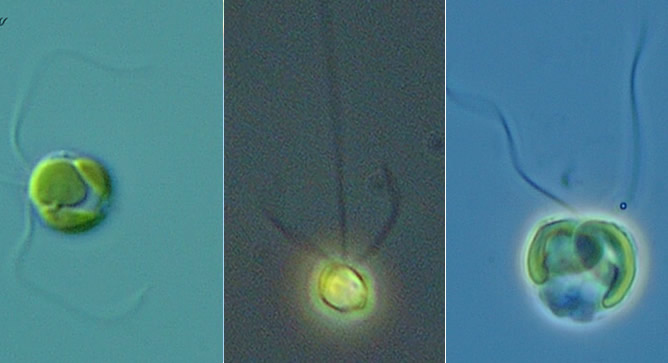| Cell | Chlorophyll | Pigments | Membranes | Thylakoids | Storage | Covering | Flagella |
|---|---|---|---|---|---|---|---|
| Eukaryotic | a, c1, c2, and sometimes c3 | Fucoxanthin, ß carotene, diadinoxanthi, diatoxanthin | 4 | 3 | chrysolaminarin, paramylon | cellulose, calcified scales | 2 equal + haptonema |

| Bob Andersen, D. J. Patterson via MBL (micro*scope) | Bob Andersen, D. J. Patterson via MBL (micro*scope) | Bob Andersen, D. J. Patterson via MBL (micro*scope) |
Haptophytes, also called prymnesiophytes, are tiny, unicellular flagellate algae.
The haptophytes are considered to include two groups of flagellate organisms. First, they contain a group of planktonic motile, naked (lacking scales) golden algae. Second, they contain a group of algae that are covered by coccoliths, which are microscopic disc-like structures composed of calcium carbonate, and called coccolithphorids. Both of these groups within the Haptophyta are small planktonic algae, and measure from 2 - 20 µm in size. These cells are considered nannoplankton, and along with the picoplankton (cells 0.2 – 2 µm) are responsible for most of the primary production in the areas of open ocean. Primary production is a measure of the carbon (CO2) fixed through photosynthesis into chains of carbon molecules (carbohydrates). In other words, primary production is the conversion of solar energy into chemical energy by the process of photosynthesis. Many of the blooms of coccolithophorids are visible from space, and have been captured in satellite images. It is remarkable that tiny organisms, not visible to the naked eye, provide a significant proportion of the global carbon budget. Haptophytes also have global impacts through their production of sulfur compounds, including dimethyl sulfide (DMS). The haptomonad Phaeocystis poucheti produces DMS, a volatile gas. In the atomosphere, DMS is transformed into tiny drops of sulfuric acid, where it aids in formation of clouds. As a result, this microscopic species contributes a significant influence on the acidity of rainwater and influences the climate.
Structure
In common with the chrysomonads, haptophytes are golden yellow in color. They contain the accessory pigments fucoxanthin, ß carotene, diadinoxanthin, diatoxanthin. Haptophytes, however, are distinguished by possessing haptonemes, scales, and in some forms, coccoliths. Recent work has shown that the two groups (those lacking scales and those with coccoliths) represent different stages in life history of the same organisms. Haptonemes are thread-like structures that are located between two equal length flagella (or undulipodia). Cells use the haptoneme to attach to stable objects, as well as grabbing prey for eating. The scales of haptophytes are produced inside the cell and coated with calcium carbonate crystals.
Prymnesiophytes in Rocky Mountain Lakes
Species in the genus Chrysochromulina are common in Rocky Mountain lakes. These tiny cells are able to both photosynthesize and engulf prey.
1 taxa shown below, 1 of which appear in at least one sample.
| Name | Basionym | Synonyms | Lakes | Samples | Region* | ID |
|---|---|---|---|---|---|---|
| Chrysochromulina sp. | 2 | 123 | RMNP, SLW, | 7001 |
Region:
RMNP = Rocky Mountain National Park, CO
SLW = Silver Lakes Watershed, CO
Images are not scaled. An individual that looks bigger than its neighbors might actually be smaller. All images were made to fit within an area of 360px high and 200px wide.
 Chrysochromulina sp. Length 2.3-3 µm Width 3-4.5 µm |

